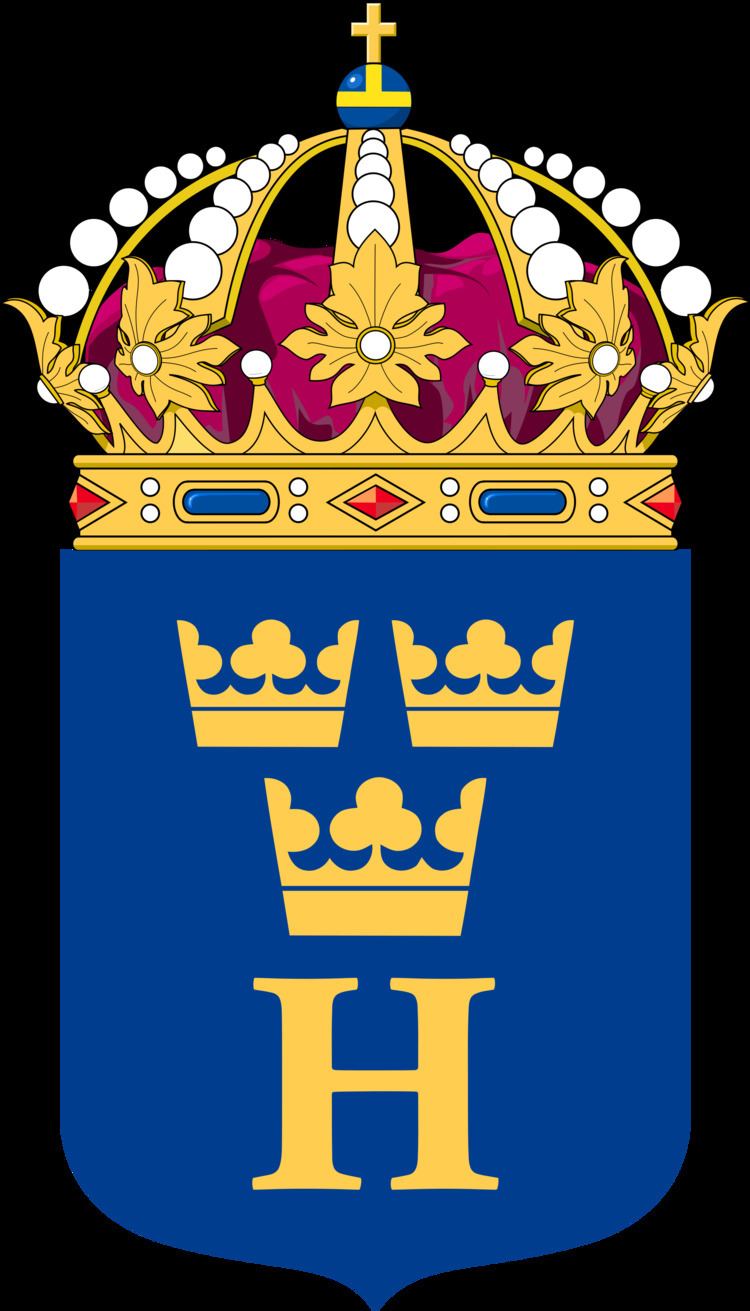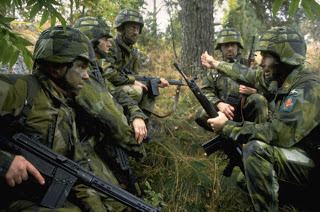Founded 29 May 1940 | ||
Similar Profiles | ||
The Home Guard – National Security Forces (Swedish: Hemvärnet – Nationella skyddsstyrkorna) is a military reserve force of the Swedish Armed Forces. It was formally established on May 29, 1940, during World War II upon popular demand. While originally composed of former militia groups, today it comprises half of the Swedish Army, thus constituting the basis of the territorial defence of Sweden.
Contents
- History
- Organisation
- Territorial organisation
- Units
- Method of operation
- Requirements
- Training
- Equipment
- Home Guard Bands
- Home Guard Cadets
- Associated organisations
- Commanders
- Hemvrnschefer
- Rikshemvrnschefer
- References
The Swedish National Home Guard consists mainly of local rapid response units, numbering 17,000 of the 22,000 total Home Guard strength, organised in 40 battalions, with 23 associated auxiliary defence organisations. The majority of the soldiers maintain a civilian job while serving the army part-time. Contemporary rapid responsee units were formed in the early 2000s as a consequence of the Swedish government's abolishment of the conscription to the Swedish Armed Forces.

The Commander, Rikshemvärnschefen, is the head of the Home Guard, representing 40 000 present and veteran soldiers, reporting directly to the Supreme Commander of the Swedish Armed Forces.

History
The establishment of the Home Guard was passed into law by the Riksdag on May 29, 1940, after the beginning of World War II, however, units had already been formed by the military before this. Home Guard units were groups of usually eight to 15 men that were to serve as defense units in case of war, located in towns and in both private and state-owned factories, throughout all of Sweden. Members of these small units usually consisted of former professional military men who were equipped with rifles, machine guns, ammunition, medicine, uniforms, and had the option of buying additional materials such as skis, sweaters and marching boots. An additional group, called the Lotta corps (Women's Voluntary Defense Service), helped with additional tasks that the Home Unit was unable to perform themselves. The Lotta corps helped provide the home unit with additional items such as socks, scarves and gloves as well as performing all administrative work that the unit could not afford to do themselves. In case of war, and in case the Home Guard was unable to utilize local hospitals, the Swedish Red Cross was prepared to set up first aid stations for its use.
Organisation
The Home Guard with the national security forces are part of the Swedish Armed Forces' mission-based organization. The Home Guard is a unit and constitutes the basis for the protection of Sweden. It has the task of operating over the entire conflict scale, from societal support during great strains in peacetime to armed combat in times of war.
The units of the Home Guard have a response capability that is measured in hours, as opposed to days or weeks. The personnel is made up of locally recruited volunteers and consists largely of experienced soldiers and officers with a background in mission-based units.
When the Armed Forces are called in to help with forest fires, flooding or missing person searches, it often falls to Home Guard units to support the police and Rescue Services. Territorial surveillance, base security, escort duties, transport protection, target identification and artillery spotting are other typical Home Guard duties.
In addition to personnel who have completed their national service or Basic Military Training, the Home Guard includes a large proportion of specialists, for example, paramedics, motorcycle orderlies and dog handlers, that are recruited and trained by voluntary defense organizations.
Territorial organisation
Sweden is divided into four military regions:
Home Guard battalions are supported for administration, training and logistics by 22 Training Groups (Swedish Utbildningsgrupp). The Training Groups are for the most parts the descendents of disbanded regiments and most Home Guard battalions carry the colours and traditions of its antecedent regiment, e.g. the 17. Dalabataljonen which carries the colours and traditions of the Dalarna Regiment (raised 1628 and disbanded in 2000). Usually, each Training Group supports 1-2 battalions but some have four battalions. The Training Groups in turn belong to a regular regiment. Uniform guidelines and materials for courses are determined centrally by the Home Guard Combat School.
Units
As of 2012, the Home Guard consists of 22,000 soldiers (down from 42,000 in 2001) organized into 40 light infantry battalions (down from 69 in 2001) of 300-700 personnel.
In 2001, the Rapid Response units numbered around 5,000 soldiers of the total of 42,000. Rapid Response units have more combat tasks compared to the rest of the Home Guard, including escort duties. Some battalions located near the coast also have marine companies equipped with Combat Boat 90.
As of 2014, the majority of the force, 17,000 out of 22,000 soldiers will be in Rapid Response units. The decrease in number of troops comes with an equal increase in quality and modern equipment.
Method of operation
The Home Guard units are trained to be local combat units (primarily infantry but also signal troops). Although current doctrine states that Home Guard units can act anywhere within the country, local knowledge is one of the strengths of the organization. Training focuses on guard duties and weapons proficiency.
In peacetime the Home Guards main task is to help with search and rescue operations, and to provide assistance to civil society in cases of severe emergencies such as natural disasters and the like.
Requirements
The Home Guard soldier must fulfill the following requirements in order to be object to admittance:
Troops are trained regularly and conditions of suitability abilities tested continually.
Training
Contractually a member of the Home Guard must train 4 days (before 2010 20 hours) per year up to 8 days for the Rapid Response units but although the time requirement varies according to role. A prerequisite for joining the Home Guard is to have received at least 85 days of basic military training. The level of training varies widely, from basic military training to Ranger school.
The training is centered around two 4-day-long battalion exercises per year for the Rapid Response units and one 4-day exercise for the support units. These exercises are mandatory for all personnel. Apart from the mandatory training, the companies organize their own exercises, often up to 10 weekend-long exercises a year. Most soldiers do considerably more time per year than the mandatory 4 or 8 days.
Equipment
The standard armaments are Ak 4B battle rifles, (Swedish version of the German G3), with red dot sights for riflemen and with x4 optical sights for squad sharpshooters, the Ak4B can also be equipped with an M203 grenade launcher. Support weapons include the Ksp 58 machine gun, grg m/48 recoilless rifle and Pskott m/86 light anti-tank weapons. The AK4 was the standard weapon of the Swedish Armed Forces until its replacement by the AK5 (FN FNC derivative). Psg 90 sniper rifles are also issued to designated snipers and some personnel (usually officers, senior non-commissioned officers, dog handlers and support personnel) are issued with Pistol 88 pistols. Other equipment includes anti-tank mines and manually detonated anti-personnel mines, explosives and signals equipment. Second generation night vision equipment is also used, but illumination flares are mainly used. Signals equipment at platoon level include Ra180 backpack radios and individual radios are issued to riflemen. In 2015, some battalions started recruiting mortar platoons equipped with 120 mm m/41D mortars.
Dogs are also used as sensor systems, usually two for every platoon. The animals are issued and trained by one of the national auxiliary defence organizations.
The rapid response units have thus far been equipped with Volvo C303 cross country vehicles and Bandvagn 206 tracked carriers. Currently the introduction of a modified Mercedes Sprint 316 (Personbil 8) is underway to replace the earlier wheeled vehicles.
Home Guard Bands
Military traditions are strongly connected with military bands and marches, etc. The bands, with diverse military musicians, fulfil the task to replace professional military bands. Throughout Sweden, there are about 32 Home Guard bands which total more than 1 500 members, such as Södertörn Home Guard Band. 17 bands are qualified for performance at state ceremonies, royal visits and festivities. Aside from the bands, Home Guard Bugle Bands also are in service within their respective areas, doing tasks formerly done by the now defunct drum and bugle corps of the Armed Forces.
Home Guard Cadets
The Home Guard Cadets (hemvärnsungdomar) is a youth section consisting of young girls and boys aged 15–20, typically recruited at age 15-16. The Cadets receive military training that includes base building, L-ABCDE first aid, CPR, communications, physical training, orienteering, defense studies, basic firearms training (with .22 long rifle up to age 16 and AK4 B with red dot sight from age 17) and from age 17 and up also patrolling and leadership training (group and platoon). At 18, a Cadet is allowed to undergo battle training. Despite this they are not officially called soldiers.
Although there is no rank system for Cadets, the training consists of 4 1-year-long blocks named Basic Course, Continuation Course, Leadership Course Level 1 and Leadership Course Level 2 (Grundkurs, GK; Fortsättningskurs, FK; Ledarskapskurs 1, LK1; and Ledarskapskurs 2, LK2. LK1 and LK2 are sometimes called Practical Course, PK, and Instruktörskurs, IK which means Practical Course and Instructor Course). After 4 years as a Cadet, the 19- to 20-year-old has received military training equivalent to 85 days of basic military training, plus basic commander training.
Typically, the Cadets train one day or evening every or every other week, with 10-12 weekends per year spent in the field. The Home Guard Cadets is the "unit" who spend the most time out on the field in the whole Home Guard. During training they wear the same type of uniform and equipment as the regular forces, although it may vary between the sections depending on local budget and resources. From 2008, a Cadet at least 18 years of age who has completed at least the 3 first blocks of training is welcome to take a course to repeat and improve learned skills in order to serve in the regular Home Guard at age 20. This is very valuable to many of them, since many of them won't be needed in the Army, Navy or Air Force but still are eager to do military service.
Associated organisations
The Home Guard also includes staff from eight voluntary organisations, so-called contractual organisations:
Commanders
Commanders of the Home Guard:
